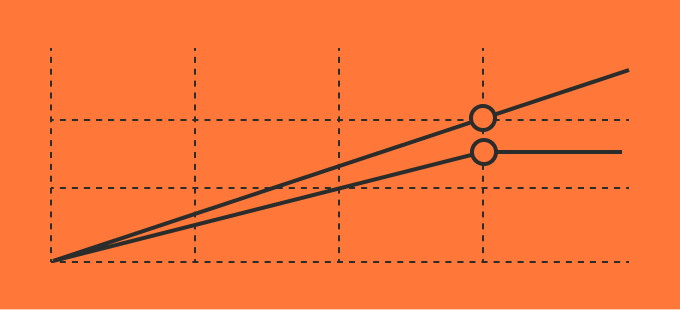- Early-stage businesses
- Lack of upsell/expansion opportunities
Gross Revenue Retention
If your business has reasonably consistent pricing and not a ton of room for expansions and upsells, then consider the Gross Revenue Retention Plan template. Remember, there’s a cap on GRR plans.
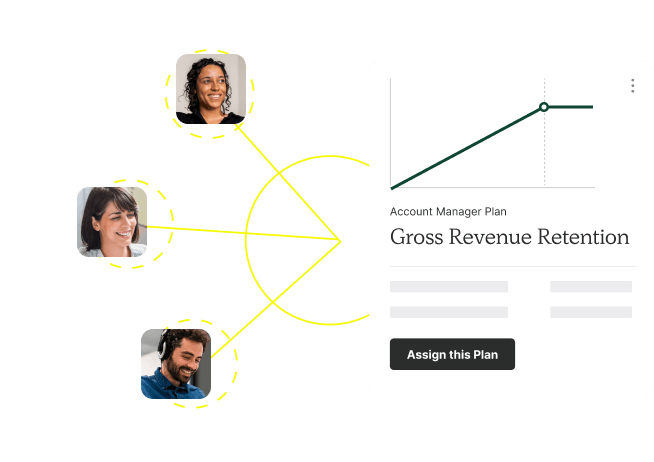
When to use this plan?
Why use a GRR plan?
Focuses AMs’ attention exclusively to keeping customers
Create a Gross Revenue Retention Plan
Like this plan? Sign up for QuotaPath to build this plan and adjust the variables.
Forecast earnings & plan performance
See potential earnings based on your inputs and goal attainment progress.
Test plan proposals
Connect your sales source of truth to test previous sales cycle data against your drafted plan.
Streamline plan management
Assign the plan to your team and automate sales commission calculations. Be confident that your team is being paid fairly and accurately.
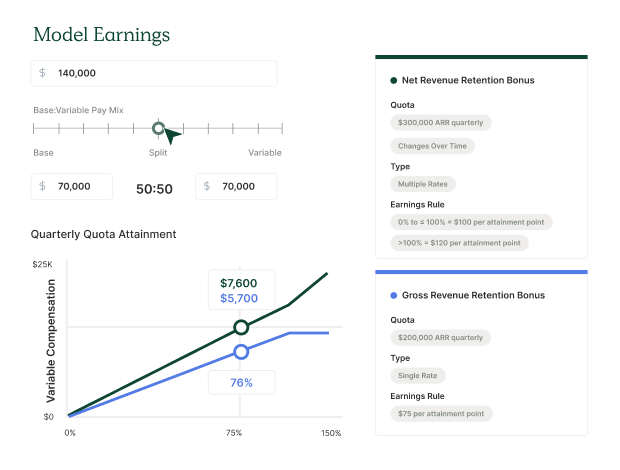
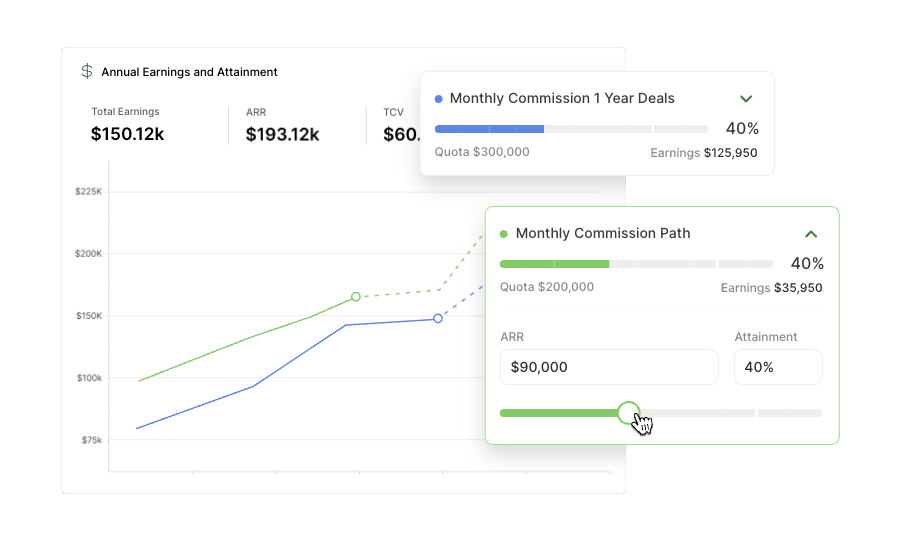
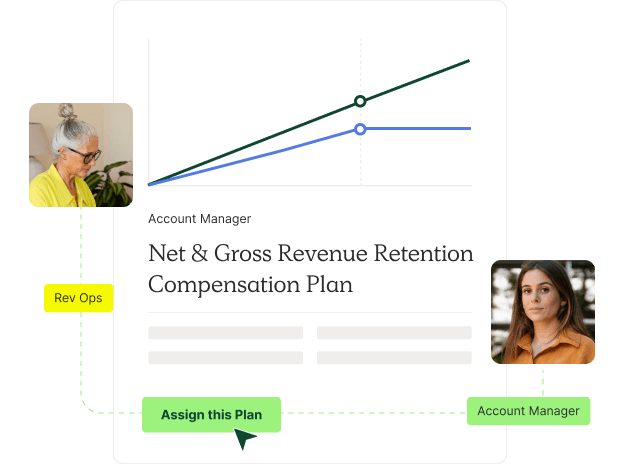
How to adjust this compensation plan template
Adjust the following variables to build this plan for your business.
Pay Mix
Pay mix combines the base salary and on-target variable pay ratio. You might see 50/50, 60/40, or 70/30 pay mixes for account manager roles.
Company Revenue
Revenue is a company’s total income from its primary operations. In SaaS, annual recurring revenue is a crucial metric for many organizations.
Book of Business
This is the portfolio of assigned customers they are responsible for managing and growing. Some focus on the number of customers, while others measure the amount of revenue.
Quota
This will vary depending on the industry or company but will be based on a retention percentage that is often less than 100%.
Quota Period
For account managers, the most common quota period is quarterly, which is the time interval between the quota resetting.
What is an account manager?
An account manager in SaaS manages the post-new biz relationship between the company and the customer, similar to a customer success manager role. They are primarily responsible for ensuring that customers are satisfied with the SaaS product or service and that their needs are being met by acting as a liaison and resolving issues.
They also work closely with the sales and customer support teams to identify opportunities for upselling and cross-selling additional products or services.
What does an account manager do?
In addition to maintaining positive relationships with customers, an account manager may also be responsible for analyzing customer data and developing strategies to improve customer retention and increase revenue.
Overall, an account manager in SaaS plays a critical role in ensuring customer satisfaction, building long-term relationships with customers, and driving revenue growth for the company.
What is a typical account manager salary?
Account managers made an average salary of $72,000 in 2023, according to Built In. However, it’s important to note that compensation can vary depending on factors such as location, industry, and experience. This number does not include their total compensation package and on-target earnings.
What is a typical SaaS account manager commission?
Account managers earn an average of $40,000 in variable compensation, according to 2023 data from Built In. This number will vary according to industry, location, experience, and how the organization sets up its commission structure.
How are account managers compensated?
Account managers are most often compensated under a commission structure that includes a base salary and commission pay mix. How the SaaS account manager commission is determined depends upon what the company wants the AM to focus on.
For instance, if the organization wants the AMs focused on leading indicators such as onboarding times, NPS scores, number of QBRs conducted, and adoption rates, the structure will differ from a business that strictly wants their AMs renewing accounts.
Also worth noting: AMs typically see a higher base salary than their sales counterparts. This is because AMs spend much more of their time supporting customers with support-related issues and less on factors outside their control.
What is an 80/20 bonus structure?
The “80/20” is the percentage split between the base salary and bonus. Under this structure, the base salary makes up 80% of the employee’s total compensation, while the bonus, or commission, makes up the remaining 20%.
How much does an account manager make?
In 2023, according to Built In, account managers made an average of $114,000 in total compensation.
What are the best compensation plans for account managers?
The best compensation plans for account managers are both simple in design and impactful as far as driving the right behaviors.
If you want your AMs solely focused on renewing the existing customer base, we recommend this comp plan example, the Gross Revenue Retention AM.
Now, if you want your AM team focused on keeping the dollars you have, or finding upsells with renewing customers to make up for churned customers, the Net Retention Revenue compensation plan might be more suitable.
You could also combine the two in the Gross & Net Revenue Retention AM Comp Plan. In this comp plan, you split the total business between GRR and NRR so that the number doesn’t alter quarter-over-quarter.
What is the difference between GRR vs NRR?
GRR (Gross Revenue Retention) and NRR (Net Revenue Retention) are both metrics used to measure the revenue retention of a SaaS company, but they differ in their calculation and the insights they provide.
GRR measures the total revenue retained from a customer base without considering any expansion revenue. It takes into account all the revenue from the beginning of the period, including upgrades, downgrades, and churned customers. The formula for GRR is:
GRR = (Total revenue from current customers at end of period – Total revenue from current customers at the beginning of period) / Total revenue from current customers at the beginning of period
NRR, on the other hand, measures the revenue retained from a customer base after accounting for both churn and expansion revenue. It considers not only the revenue from the beginning of the period but also the revenue generated from upsells, cross-sells, and new business from existing customers during the period. The formula for NRR is:
NRR = (Total revenue from current customers at end of period – revenue from churned customers) / Total revenue from current customers at the beginning of period) x 100
While GRR is useful for understanding how well a company is retaining its customer base, NRR provides a more complete picture by factoring in the revenue generated from existing customers. NRR can help companies understand the impact of customer expansion on their overall revenue, and identify opportunities for growth and customer success.
What is the difference between a CSM and an AM?
At early-stage companies, we often see this role interchange. Sometimes a company only has AMs or only CSMs. But in the case they have two distinct teams, the difference is normally as follows:
A CSM is responsible for ensuring that customers achieve their desired outcomes with the SaaS product or service. They work closely with customers to understand their goals, develop success plans, and provide guidance and support to help customers achieve those goals. CSMs are focused on ensuring the long-term success and satisfaction of customers.
An AM, on the other hand, manages the relationship between the SaaS company and its customers. AMs work to resolve any issues or concerns that the customer may have, and they may also identify opportunities for upselling and cross-selling additional products or services. The primary goal of an AM is to maintain positive relationships with customers and drive revenue growth for the company.
While both roles are focused on customer satisfaction and retention, CSMs tend to be more focused on the overall success of the customer, while AMs are focused on the business relationship and revenue growth.
Explore similar compensation plans
What industry leaders say
Manage compensation & track commissions with QuotaPath
Deliver visibility, automation, and seamlessness across the entire compensation process.

